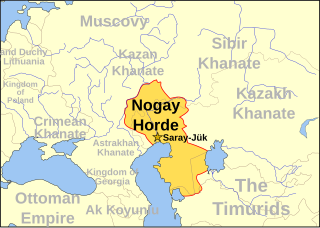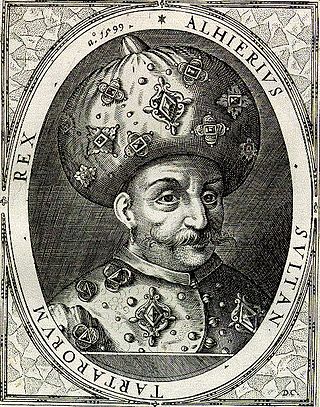
The Mongol Empire invaded and conquered much of Kievan Rus' in the mid-13th century, sacking numerous cities including the largest such as Kiev and Chernigov. The Mongol siege and sack of Kiev in 1240 is generally held to mark the end of Kievan Rus' as a distinct, singular polity. Many other Rus' principalities and urban centres in the northwest and southwest escaped destruction or suffered little to no damage from the Mongol invasion, including Galicia-Volhynia, Novgorod, Pskov, Smolensk, Polotsk, Vitebsk, and probably Rostov and Uglich.

The Tatars, formerly also spelt Tartars, is an umbrella term for different Turkic ethnic groups bearing the name "Tatar" across Eastern Europe and Asia. Initially, the ethnonym Tatar possibly referred to the Tatar confederation. That confederation was eventually incorporated into the Mongol Empire when Genghis Khan conquered the various steppe tribes. Historically, the term Tatars was applied to anyone originating from the vast Northern and Central Asian landmass then known as Tartary, a term which was also conflated with the Mongol Empire itself. More recently, however, the term has come to refer more narrowly to related ethnic groups who refer to themselves as Tatars or who speak languages that are commonly referred to as Tatar.

The Golden Horde, self-designated as Ulug Ulus was originally a Mongol and later Turkicized khanate established in the 13th century and originating as the northwestern sector of the Mongol Empire. With the division of the Mongol Empire after 1259, it became a functionally separate khanate. It is also known as the Kipchak Khanate or as the Ulus of Jochi, and it replaced the earlier, less organized Cuman–Kipchak confederation.

The Crimean Khanate, self-defined as the Throne of Crimea and Desht-i Kipchak, and in old European historiography and geography known as Little Tartary, was a Crimean Tatar state existing from 1441 - 1783, the longest-lived of the Turkic khanates that succeeded the empire of the Golden Horde. Established by Hacı I Giray in 1441, it was regarded as the direct heir to the Golden Horde and to Desht-i-Kipchak.

The Nogai Horde was a confederation founded by the Nogais that occupied the Pontic–Caspian steppe from about 1500 until they were pushed west by the Kalmyks and south by the Russians in the 17th century. The Mongol tribe called the Manghuds constituted a core of the Nogai Horde.

The Polish–Ottoman War of 1633–1634 was one of the many military conflicts between the Crown of the Kingdom of Poland together with the Grand Duchy of Lithuania and the Ottoman Empire and its vassals.

The Battle of Podhajce took place on 8–9 September 1698 near Podhajce in Ruthenian Voivodship during the Great Turkish War. 6000-strong Polish army under Field Crown Hetman Feliks Kazimierz Potocki repelled approximately 14,000 man Tatar expedition under Qaplan I Giray.

Terebovlia is a small city in Ternopil Raion, Ternopil Oblast, western Ukraine. Terebovlia hosts the administration of Terebovlia urban hromada, one of the hromadas of Ukraine. Population: 13,226 ; 13,661 (2001).
The Russo-Crimean Wars were fought between the forces of the Tsardom of Russia and the Crimean Khanate during the 16th century over the region around the Volga River.
Khan Temir was a steppe warlord and raider. He ruled the Budjak Horde in what is now the southwestern corner of Ukraine (Budjak) along the Romanian border. Budjak is the southwesternmost corner of the Eurasian Steppe. He raided mostly along the eastern frontier of the Polish Commonwealth. Nominally a vassal of the Ottoman Empire, the Ottomans used him to pressure the Poles just as the Poles used the Zaporozhian Cossacks to pressure the Ottomans and Crimeans. His habit of acting independently caused problems. The Ottomans several times tried to move him east from Poland and eventually executed him. The most important event in his life was his conflict with the Crimean khan in 1628.

The Polish-Ottoman Wars were a series of conflicts that took place between the Polish-Lithuanian Commonwealth and the Ottoman Empire during the 16th and 17th centuries. These wars were part of the broader struggle for dominance in Eastern Europe between Christian and Muslim powers. The conflicts involved territorial disputes, religious differences, and power struggles in the region.

The Mongol Invasion of Poland from late 1240 to 1241 culminated in the Battle of Legnica, where the Mongols defeated an alliance which included forces from fragmented Poland and their allies, led by Henry II the Pious, the Duke of Silesia. The first invasion's intention was to secure the flank of the main Mongolian army attacking the Kingdom of Hungary. The Mongols neutralized any potential help to King Béla IV being provided by the Poles or any military orders.

The Nogais are a Kipchak ethnic group who live in the North Caucasus region. Most are found in Northern Dagestan and Stavropol Krai, as well as in Karachay-Cherkessia and Astrakhan Oblast; some also live in Chechnya, Dobruja, Turkey, Kazakhstan, Uzbekistan, Ukraine and a small Nogai diaspora is found in Jordan. They speak the Nogai language and are descendants of various Mongolic and Turkic tribes who formed the Nogai Horde. There are eight main groups of Nogais: the Ak Nogai, the Karagash, the Kuban-Nogai, the Kundraw-Nogai, the Qara-Nogai, the Utars, Bug-Nogai and the Yurt-Nogai.

Ğazı II Giray was a khan of the Crimean Khanate. Born in 1554, he distinguished himself in the Ottoman–Safavid War (1578–90), gaining the trust of his Ottoman suzerains. He was appointed khan in 1588, after his homeland experienced a period of political turmoil. He failed to capture Moscow during his 1591 campaign against Tsardom of Russia, however he managed to secure a favorable peace treaty two years later. He was then summoned to support his Ottoman allies in the Long Turkish War, taking part in multiple military expeditions centered in Hungary. In late 1596, the Ottoman sultan briefly unseated Ğazı II Giray in favor of Fetih I Giray after heeding the advice of Grand Vizier Cığalazade Yusuf Sinan Pasha. He returned to power three months later, continuing his reign until his death in November 1607.

The Kalmyk Khanate was an Oirat khanate on the Eurasian steppe. It extended over modern Kalmykia and surrounding areas in the North Caucasus, including Stavropol and Astrakhan. During their independence, the Kalmyks both raided and allied with Russia in turn, engaging in numerous military expeditions against the Crimean Tatars, the Ottoman Empire, neighboring Muslim tribes, and the highlanders of the North Caucasus. The Khanate was annexed by the Russian Empire in 1771.

Crimean–Nogai slave raids in Eastern Europe were the slave raids, for over three centuries, conducted by the military of the Crimean Khanate and the Nogai Horde primarily in lands controlled by Russia and Poland-Lithuania as well as other territories, often under the sponsorship of the Ottoman Empire.

The Mongol (Tatar) clique of Nogai Khan, a part of the larger Golden Horde, was heavily involved in the Kingdom of Serbia in the 1280s and 1290s. A serious invasion was threatened in 1292 but was averted when Serbia accepted Mongol lordship. The Balkan push of Nogai's clique was broader than just Serbia. In 1292, it resulted in the deposition and exile of King George I of Bulgaria.

Duchy of Podolia was a historical state that previously was a part of Kingdom of Galicia–Volhynia. The principality of Southwest Galicia–Volhynia, which was formed as a result of the struggle for the legacy of the Kingdom of Galicia–Volhynia. Founded by Knyaz George Koriatovich from the Karijotas house.
The Kanzhal War or Crimean-Circassian War of 1708 was military conflict in 1708 fought between 7,000 Circassians led by Kurgoqo Atajuq and 60,000-100,000 Crimean Tatars led by Qaplan I Giray, which resulted in Circassian victory. It played a big role in decreasing foreign influence in Circassia. In 2013, the Russian Academy of Sciences described the battle as "an important event in the history of Circassians". It was fought near the village of Bylym on the Baksan River.
The Temryuk War or Crimean-Circassian War of 1551–1556 was a military conflict between the Crimean Khanate and the Kabardian Principality.















